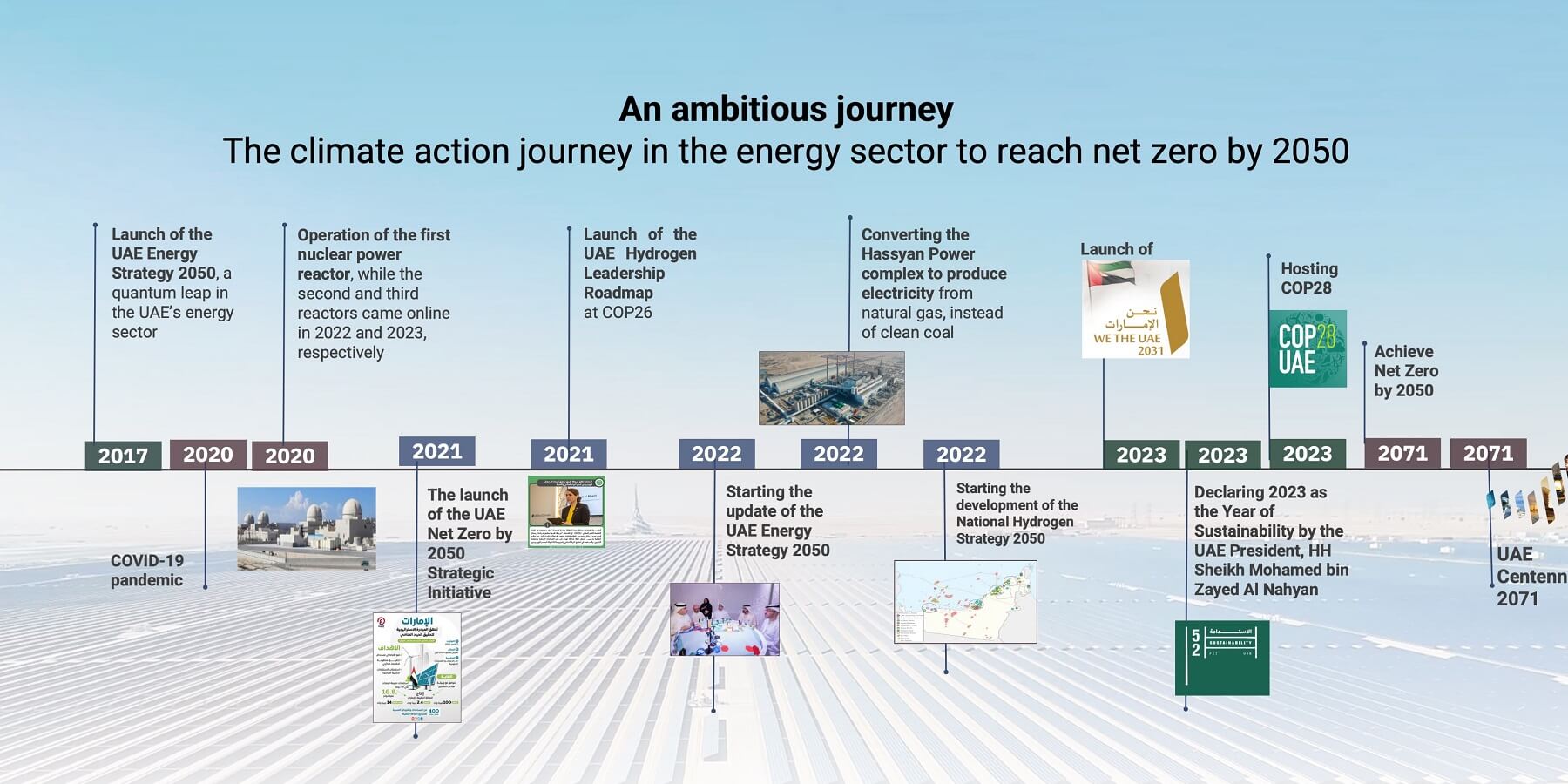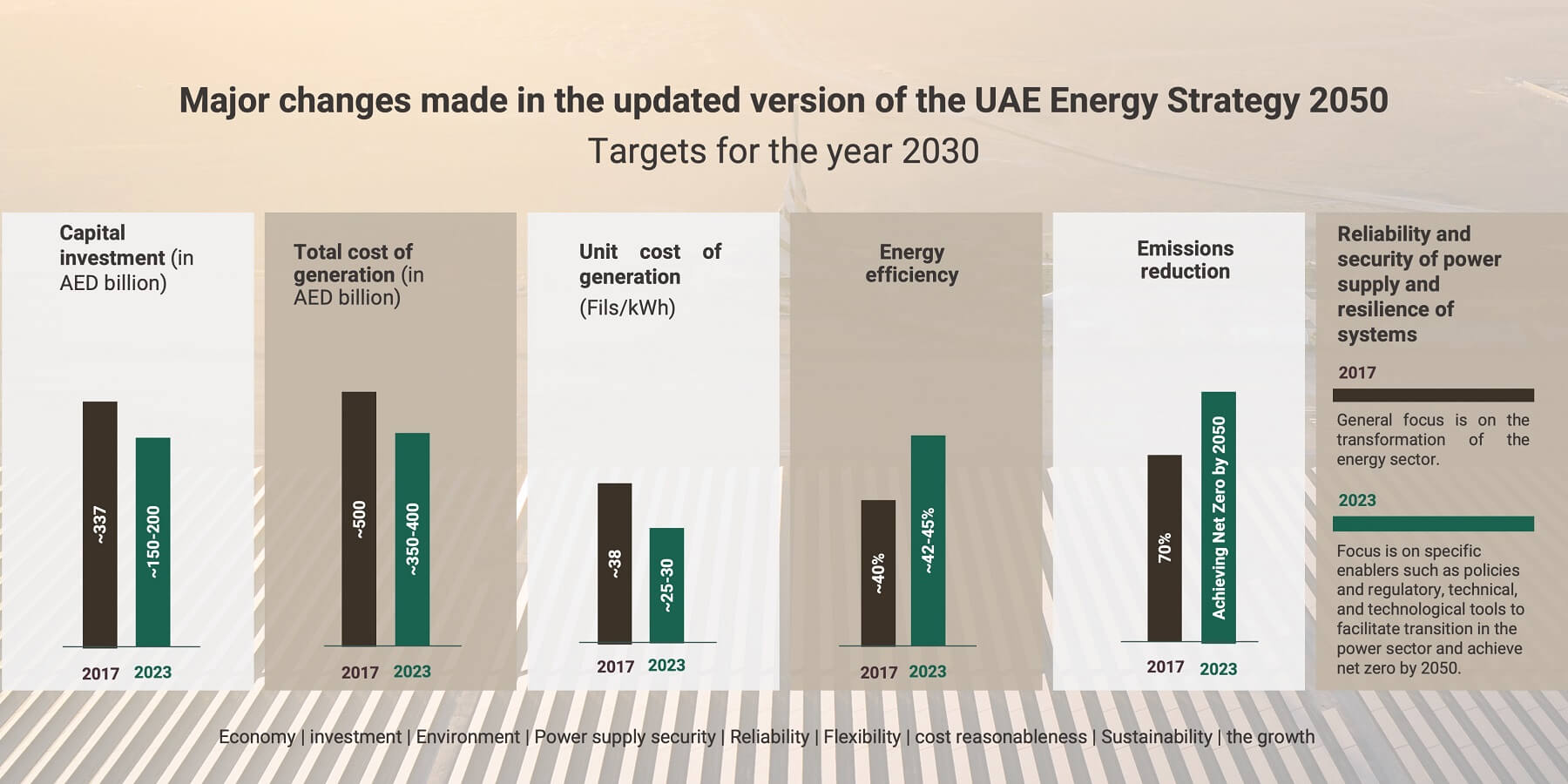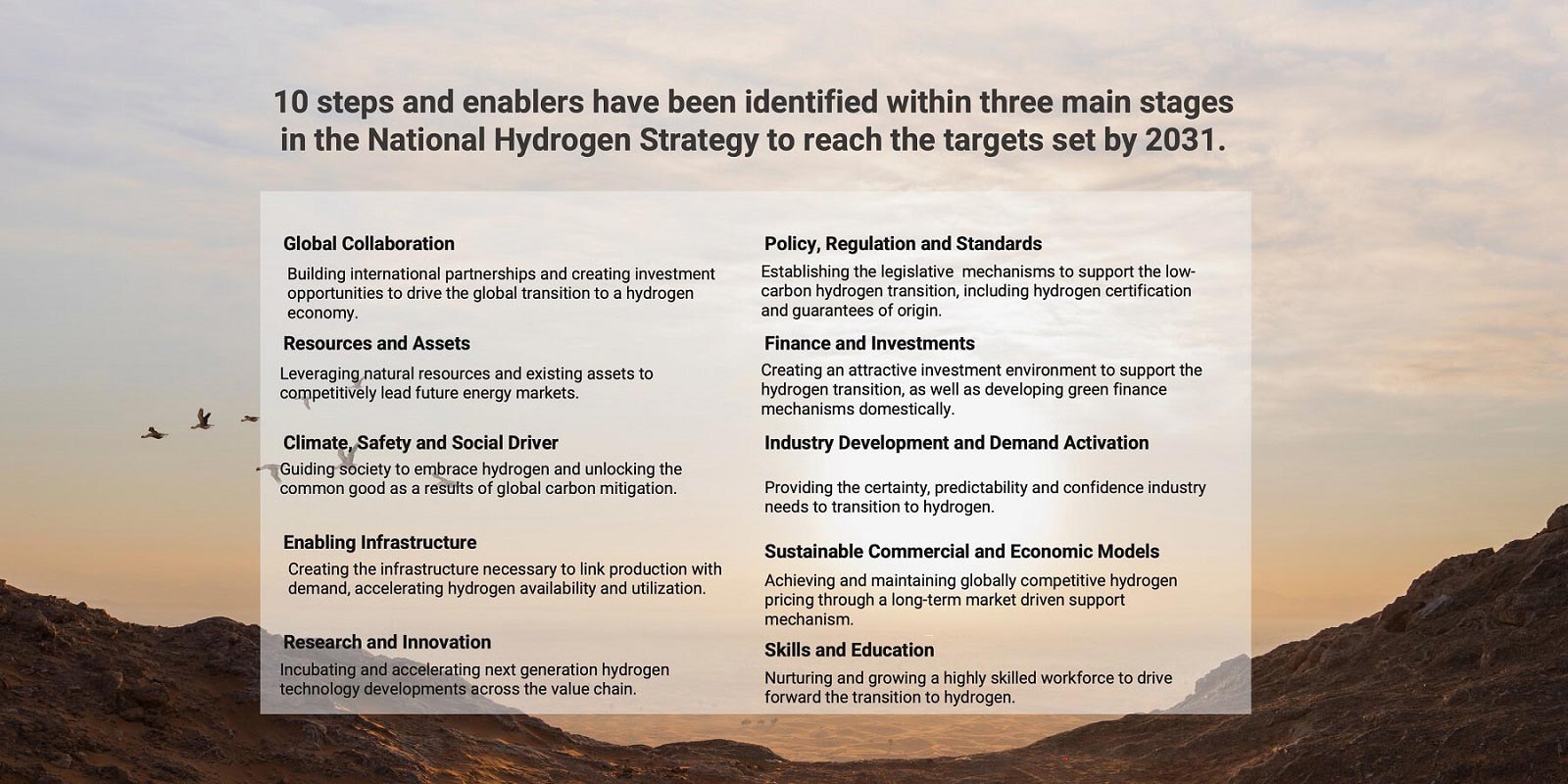The UAE Energy Strategy 2050
To accommodate the developments of the energy sector, the UAE approved its Energy Strategy 2050, which primarily aims to triple the contribution of the renewable energy and invest AED 150 to AED 200 billion by 2030 to meet the country’s increasing demand for energy as a result of a rapidly growing economy.

The UAE energy transition started before the formation of the union in 1971. Building on the country’s long-standing commitment to climate action and energy transition, the UAE Energy Strategy 2050 was launched in 2017 as the first unified energy strategy in the country that is based on balancing supply and demand with environmental obligations and creating a conducive economic environment for growth.
Given the recent dynamic changes in the energy sector regarding the global energy security and climate change, as well as the reduction in prices and the maturity of emerging low-emission energy technologies, and the country’s commitment to the objectives of the Paris Agreement, the UAE Energy Strategy 2050 was updated, setting goals for 2030 and ambitions for 2050 to reach net zero. The move aligns with the UAE President His Highness Sheikh Mohamed bin Zayed Al Nahyan’s declaration of 2023 as the Year of Sustainability, under the theme ‘Today for Tomorrow’, which reflects His Highness’s keenness on integrating sustainability principles across the board.
The updated strategy aims to promote the deployment of renewable and nuclear energies, enhance energy efficiency, drive R&D and innovation in energy technologies, increase local clean energy capacity, and encourage investments in the country’s renewable and clean energy sector.
The UAE Energy Strategy 2050 helps the UAE maintain its leadership and improve its competitiveness in the energy sector. It enhances international partnerships to support sustainability objectives in the energy sector.
The updated strategy outlines a long-term national program to balance meeting the rising energy demand and sustaining natural resources for generations to come. In the first phase, which runs till 2030, the strategy aims to:
- Reduce emissions from the water and energy sectors to ensure they achieve net zero by 2050
- Eliminate the contribution of clean coal to the energy mix, ensuring the country's leadership and achieving climate neutrality goals
- Increase individual and institutional energy consumption efficiency by 42-45%, compared to 2019
- Triple the share of renewable energy
- Increase the installed clean energy capacity from 14.2 GW to 19.8 GW
- Surge the share of installed clean energy capacity in the total energy mix to 30%
- Increase the contribution of clean energy generation to 32% to ensure the country is on track to achieve its climate change mitigation goals.
- Create 50,000 new green jobs
- Achieve financial saving of AED 100 billion and mobilize investments between AED 150-200 billion to ensure energy demand is met and to sustain economic growth in the UAE

The UAE has one of the lowest grid emission factors, compared to the global average. It aims to achieve a grid emission factor of 0.27 kg CO2/kWh by 2030.
The National Hydrogen Strategy 2050
As hydrogen emerges as one of the most important types of clean energy, the National Hydrogen Strategy 2050 aims to strengthen the UAE’s position as a producer and supplier of low-emission hydrogen by 2031 through the development of supply chains and the establishment of hydrogen oases and a dedicated national research and development centre for hydrogen technologies.
The National Hydrogen Strategy drives the country’s investments in clean energy and its contribution to the global efforts towards environmental sustainability, in line with its role as the host of the 28th UN Climate Change Conference (COP28).
It is a crucial tool to meet the country’s commitment to net zero by 2050 and the Paris Agreement.
The strategy will help accelerate the global hydrogen economy and scale up local hydrogen production to 1.4 million tons per annum (mtpa) by 2031 (consisting of 1 mtpa of green hydrogen and 0.4 mtpa of blue hydrogen), 7.5 mtpa by 2040, and 15 mtpa by 2050. Following a thorough study of hydrogen demand, the National Hydrogen Strategy forecasts local demand of low-carbon hydrogen to reach 2.7 mtpa by 2031.
An overview of the targets and predictions for hydrogen production was considered while preparing short-, medium-, and long-term scenarios for the future generation of blue, green, and pink hydrogen until 2050.
To enhance the UAE’s position as a supplier of low-emission hydrogen and achieve the country’s objectives, 10 enablers have been identified:

The strategy sets the main measures that the UAE will take to expedite the growth of the hydrogen economy and become amongst the world’s top producers of low-emission hydrogen. It will also help reduce emissions in hard-to-abate sectors, such as land, sea, and air transport, chemicals and fertilizers, and metals, including aluminum, iron, and steel, by 25% by 2031 and 100% by 2050.
The National Hydrogen Strategy involves tangible steps to establish two hydrogen oases by 2031 and increase their number to five by 2050. The strategy contributes to fostering the domestic market, developing a regulatory framework and policies that support hydrogen as a sustainable fuel for the future, strengthening regional collaboration to establish a regional hydrogen market, and bolstering investments in research and development to improve cost effectiveness of hydrogen production, transport, and utilization.
It enhances the investor confidence and helps companies develop robust supply chains. It supports the country's approach to fully utilize its abundant solar energy, natural gas resources, ability to capture and store carbon, and strategic location to unlock local hydrogen production capabilities and accelerate the global hydrogen economy.
To advance related technologies, the country will establish a research and development centre for hydrogen technologies in 2031, which will be developed into a recognised innovation centre globally for hydrogen by 2050.